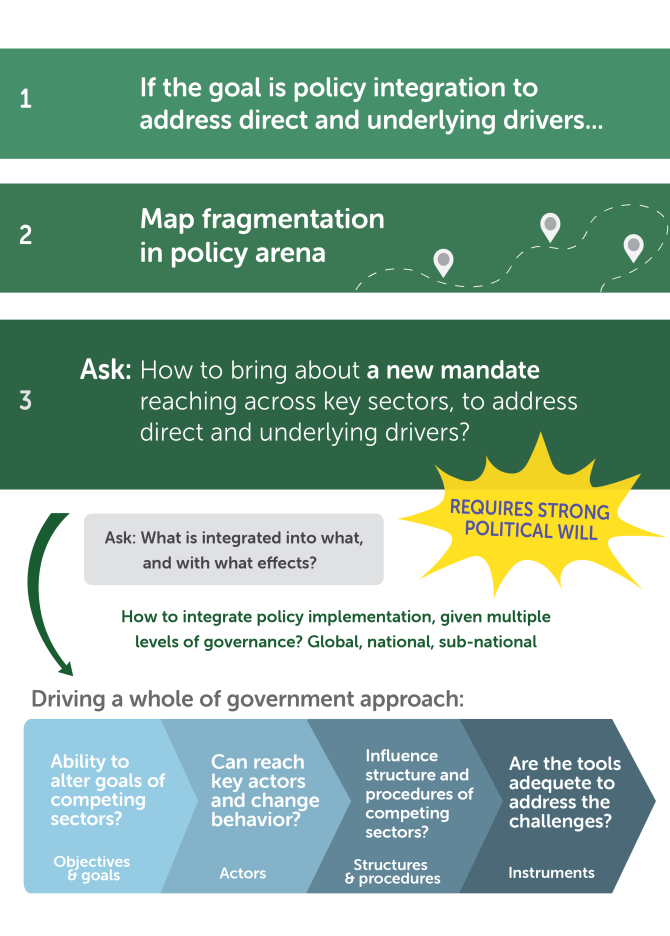
News
Policy integration, a silver bullet for climate and forests?
Policy integration is increasingly looked to as a silver bullet to weave climate objectives into sector policies that are inherently fragmented and some of which may undermine climate goals. Policy integration is also touted as a primary tool to achieve the Sustainable Development Goals. In practice, does it live up to these expectations?
Mapping the fragmentation in policy arenas
In this paper we investigate how and to what extent climate change and land use policy integration through the National REDD+ Action Plan (NRAP) has enabled Vietnam to tackle the direct and indirect drivers of deforestation in the Central Highlands—focusing on coffee and rubber sectors, which have been the largest drivers of forest loss.
We mapped the degree of fragmentation within this multi-dimensional and multi-level policy arena, in all stages of the policy process—from setting goals and objectives, to actors, policymaking structures and processes, and policy instruments, at various scales. We considered the processes (e.g. inter-agency coordination, mainstreaming) and outputs (e.g. objectives, strategies, actions), and how integration is affected by the dispersion of goals, competencies and authority across multiple levels and scales of governance.
Missing a ‘whole-of-government’ mandate
Our results show that because the NRAP was not given a ‘whole-of-government’ mandate, it was not effective in integrating its objectives into the targets and goals for the agricultural sector and the 2017 Planning Law - two key areas of planning and regulation related to key drivers. The NRAP had no clear means to reform existing policies and programmes in a way that could reach and affect the policy goals, actors and structures of sectors like coffee and rubber that underly many of the direct and underlying drivers of deforestation and forest degradation. This highlights the challenge of integrating a global governance instrument like REDD+, which is Vietnam’s forest sector component of its Nationally Determined Contribution to Paris Climate Agreement, into national and sub-national policy. Despite being designed to ensure greater consistency in how the state steers, manages and coordinates activities across multiple sectors, the NRAP has no mandate to override or influence policy goals and objectives that are not directly related to the forestry sector. Thus, key actors, especially those outside government and in sectors contributing to the underlying drivers of deforestation are largely unaffected by REDD+ .
Four ongoing fragmentations to overcome
Our analysis across these multiple levels of government reveals four ongoing ‘fragmentations’ that would need to be overcome for NRAP to affect integrative change. First, for the NRAP to foster integration, both vertically between different levels of levels of government, and horizontally between sectors and types of instruments, it would have to directly insert itself into the ‘coordinating’ administrative and legislative functions of the state. Second, to foster integration, the mandate of the NRAP would have to expand to revise both agricultural commodity development strategies (such as those for rubber and coffee) and the centrally coordinated 5-year Socio-Economic Development Plan. Third, a multi-level, whole-of government mandate to NRAP would enable it to reshape priorities of other sectors. However, it remains unclear whether such a whole-of-government mandate could have an influence on strong market pressure from those sectors driving forest conversion – as evident by the inability of pre-existing policy tools to affect commodity-area overshoots. Finally, as the NRAP was not able to bring about a new mandate or logic across the fragmented policy landscape in which it sought influence, directly influencing agricultural sector targets and programmes, the ‘integration’ sought may be better characterised as ‘pragmatic coordination.’ That resulted in incremental linkages between existing policies, actors and instruments, rather than seeking to change political will. In short, policy integration may not be able to halt deforestation if there is no political will to engage the interests driving the underlying drivers across sectors and levels of governance.
Visualizing a conceptual guide for policy integration efforts
With these research findings in mind, we offer ideas for policymakers to consider as a conceptual framework to guide policy integration efforts as a means to address fragmentation, in the pursuit of bringing climate into competing sector policies (See figure below).
